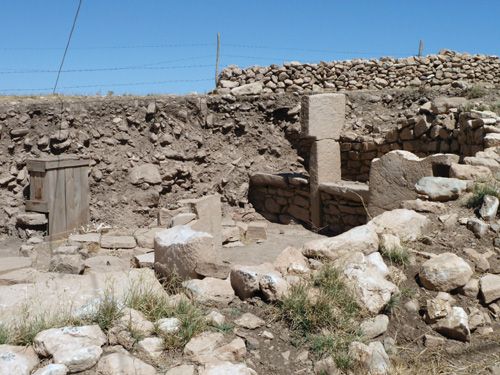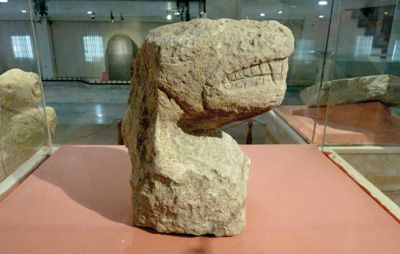gobekli tepe - genesis of the gods (30 page)

Plate 16
. The seven flightless birds, identified as dodos, carved into the southern face of the bedrock pedestal holding up Enclosure D’s Pillar 18.

Plate 17
. One of the roaring lions carved on the inner faces of the twin pillars marking the eastern end of Göbekli Tepe’s Lion Pillar Building. Built ca. 8500–8000 BC and aligned east-west, its advancing felines could well represent both the might of the sun and the constellation of Leo, the celestial lion.

Plate 18
. Göbekli Tepe’s Lion Pillar Building, located at the summit of the occupational mound some 50 feet (15 meters) higher than the site’s main enclosures, suggesting that it was constructed as much as 1,000 to 1,500 years after these earlier structures.

Plate 19
. The author, left, with Professor Klaus Schmidt, who has been excavating Göbekli Tepe on behalf of the Museum of S̨anlıurfa and the German Archaeological Institute since 1995.

Plate 20
. One of the most recent pillars to be uncovered at Göbekli Tepe. It was discovered during excavations in the northwest section of the occupational mound and could well be eleven thousand years old. It shows a south-facing lion on what is presumably the inner face of a central pillar in a previously unexplored enclosure.

Plate 21
. Göbekli Tepe’s Enclosure F, built probably ca. 8500–8000 BC. Notice how reduced in size the sanctuaries have become by this time. Some of them are no bigger than a bathroom, with stones no more than 5 feet (1.5 meters) in height.

Plate 22
. Strange carved head found among the fill that covered the enclosures at Göbekli Tepe, now in the Museum of S̨anlıurfa. Its teeth show it to be a predator, most likely a wolf.

Plate 23
. Life-size human statue dating to around 9000 BC. It was discovered in 1993 within the Balıklıgöl district of S̨anlıurfa, the oldest part of the city, and is now in the archaeological museum. Tradition asserts that S̨anlıurfa, ancient Edessa or Orhay, was founded either by the prophet Enoch or by “Orhay son of Hewya”; that is, the “Serpent,” a clear allusion to the Watchers of the book of Enoch.

Plate 24
. Carved stone totem pole discovered in one of the minor structures at Göbekli Tepe, and now in the Museum of S̨anlıurfa. Its damaged head is that of an animal, while its body is of a human. A smaller human figure emerges from its stomach, and from the womb area of the second figure comes a child that holds in its hands a vessel of some sort. Twin snakes rise up on either side, possibly as guardians of the child. This is one of the strangest pieces found so far and shows the virtually alien mindset of the Göbekli builders.

Plate 25
. Left, a Solutrean laurel-leaf spearhead, 13 inches (33 centimeters) long and around twenty thousand years old, on display at the British Museum. Right, Swiderian tanged point made of chocolate flint, eleven thousand to twelve thousand years old. Not to scale. Were the Swiderian hunters of Central and Eastern Europe, as successors of the Solutrean tradition, instrumental in the rise of Göbekli Tepe around the end of the Younger Dryas period, ca. 9600 BC?

Plate 26
. Medieval painted wooden panel in All Saints Church, Kempston, Bedfordshire, UK. It shows the removal of Adam and Eve from the Garden of Eden and the angel who wields the flaming sword. Note the serpent crawling on the ground and the Mountain of God behind Adam, both in the left-hand scene.

